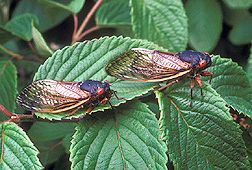“Shhh!” “Do you hear that?” “What’s that noise?”

Those are the questions people have been asking every since the male cicadas (Magicicada species) began singing in the St. Louis area during the late spring. The 13-year cicadas (Brood XIX—each cicada population that emerges in the same year is assigned a brood number by entomologists) were expected to emerge between April and June of 2011, according to the Magicicada Mapping Project, a National Geographic Sponsored Project, and they did not disappoint.
“Cicadas began to emerge at the end of April and the beginning of May as temperatures increased, but they began to sing later due to the cold weather,” says Dan Zarlinga, Media Specialist from the Missouri Department of Conservation.
Cicadas are heavy-bodied, wedge-shaped insects that have large compound eyes. The adults range in size from 0.75 to 1.5 inches in length. They have a 13-year or 17-year life cycle. Toward the end of their life, the nymphs emerge from the ground, and climb up on trees and other structures to complete a final molt before adulthood. After the molt, the male cicadas sing loudly to attract a female, who will lay her eggs under the bark of slender tree branches.
According to www.magicicada.org, a website dedicated to cicada research, after 6 to 10 weeks, the eggs hatch. The newborn nymphs drop from the trees and burrow into the ground, where they select a root to feed on for the next 13 to 17 years. However, their adult parents only live for five to six weeks.
Cicadas emerge over a wide geographic range, covering most of the United States east of the Mississippi River, according to Bruce Barrett, Professor of Entomology at the University of Missouri–Columbia. However, they have not been evenly distributed in the St. Louis area or in the state of Missouri for that matter, based on the 2011 Magicicada Brood XIX sighting maps at magicicada.org.
According to Louie H. Yang, Department of Entomology at the University of California–Davis, cicada emergence depends heavily on where female cicadas from the previous generation chose to lay her eggs. Female cicadas seem to prefer specific locations and certain plants for egg laying, such as trees that grow along roadsides or forest edges in suburban areas and early succession forests—areas that consist of very young trees and dense shrubs.
“They have a wide host range of deciduous plants, but they do seem to prefer fruit trees [such as apple, pear, crab apple, peach] and oaks, maple, elm, hickory, willow, redbud and ash,” says Robert W. Sites of the Enns Entomology Museum at the University of Missouri-Columbia.
Females also make their tree selection of tree based on the light it receives. Female cicadas prefer to lay eggs on the western side of trees with a greater light exposure and in trees with open canopies, says Yang. They seem to be choosing sites where the trees are expected to grow very well over a long time.

This work is licensed under a Creative Commons Attribution-NonCommercial-NoDerivs 3.0 Unported License














Your gifts bring the sudden happiness to your loved ones. Time may pass on, but your gifts will keep making them happy, even when there is no specific reason. Thatâ:-??s the wonder touch gifts do give to life. Visit http://www.hampersnationwide.com/Germany/Gift_Baskets_to_Germany.asp for more details.